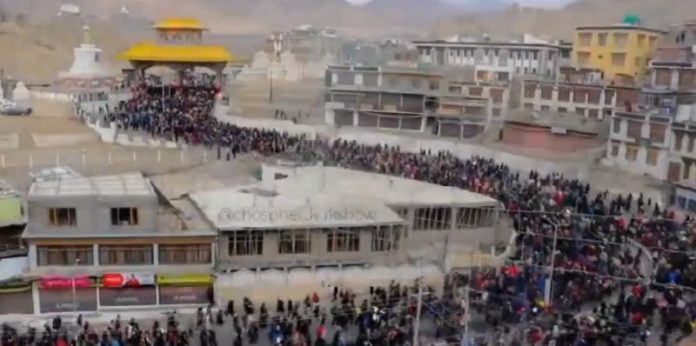In an unprecedented display of unity and determination, residents of Ladakh have taken to the streets, enduring extreme weather conditions to voice their demands for statehood, constitutional safeguards, and separate parliamentary seats for Leh and Kargil. The protests, organized by the Leh Apex Body (LAB) and the Kargil Democratic Alliance (KDA), have gained momentum, drawing attention to the pressing concerns of the region’s residents.
Despite temperatures plummeting below freezing and heavy snowfall blanketing the region, thousands of men and women marched through the streets of Leh, the main city of Ladakh, on Saturday. Bearing placards and chanting slogans, the protestors called for immediate attention to their demands, highlighting the challenges they face as a centrally-administered Union Territory.
Key Demands
The protestors have put forward four demands, namely:
- Implement the 6th Schedule of the Constitution.
- Ladakh should be given the status of a full state.
- Allot separate seats in Parliament to Leh and Kargil.
- Form Ladakh Public Service Commission for job reservation.
Accordingly, the protestors argue that these measures are crucial to addressing the socio-economic and political aspirations of the people of Ladakh.
Concerns Over Representation
Legal advisor to LAB and KDA, Haji Ghulam Mustafa, expressed concerns over the diminishing representation of Ladakh since it became a Union Territory. He emphasized that before Article 370 was abrogated, Ladakh was part of J&K state and had representation in state legislature with 4 seats reserved in Legislative Assembly and 2 seats reserved in Legislative Council. But after the abrogation, Ladakh was made a centrally governed UT with no provision of state legislature. According to protestors, this has diminished the representation of people in the crucial governance matters and that it could only be corrected through statehood for Ladakh.
It is worth mentioning here that the two Autonomous Hill Development Council, one for Leh and one for Kargil are the only elected bodies of the people, which were provisioned in 1993 and was given effect by the Ladakh Autonomous Hill Development Council Act, 1995. Apart from these two LAHDCs, Ladakh has only one seat representation in Parliament.
Response from the Central Government
As a matter of fact, the ruling party at the centre, i.e., Bhartiya Janta Party (BJP) had, in 2020, maintained that it supports the inclusion of UT into the 6th schedule of the constitution to protect the land, jobs and environment by focusing on Ladakh’s unique linguistic and ethnic identity.
The central government has taken note of the growing unrest, forming a high-level committee, led by Union Minister Nityanand Rai, to address Ladakh’s concerns. While the government’s response indicates a willingness to engage with the issue, protestors contend that concrete steps, such as the restoration of full statehood and the implementation of the 6th Schedule provisions, are imperative for the region’s well-being. Notably, the 6th schedule of the Indian Constitution describes the establishment of autonomous district councils (ADCs) in tribal areas populated by indigenous groups. Accordingly, these ADCs aim to safeguard and maintain tribal culture.
As per protestors, implementation of 6th schedule will pave way for the safeguarding of ethnic rights and claims of indigenous people. With due consideration, this demand is more focused on maintaining the autonomy of the local people so as to guarantee no demographic changes in Ladakh.

